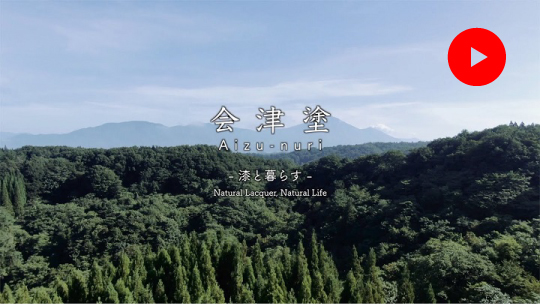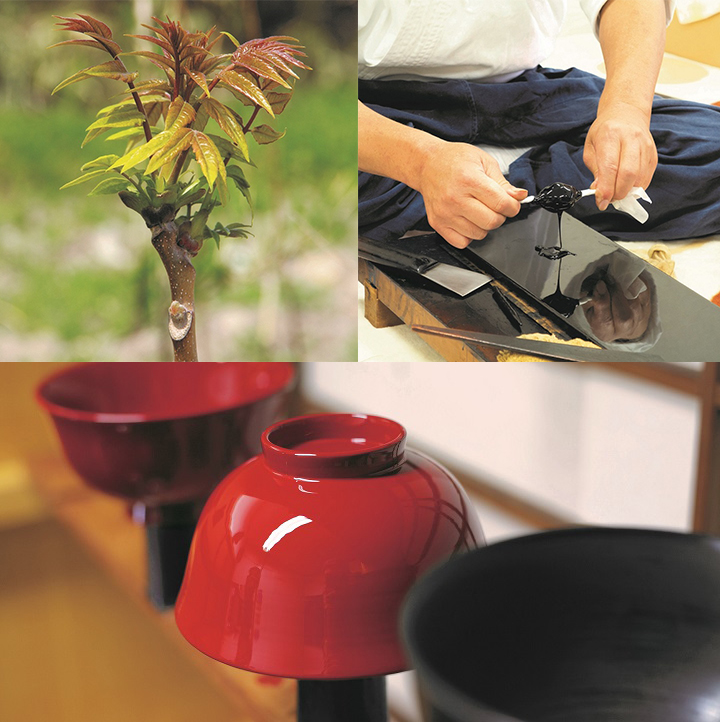

漆のチカラ
The power of
urushi


Aizu
3 hours north of Tokyo.
Thousands of years ago, people gathered in this region encompassed by mountains, and blessed with abundant water and fertile land. They built villages in nature and made tools for life and agri-culture, advancing civilization in various ways.
At the end of the Edo Period, it was the largest cultural and economic center in Tohoku, with nearly the same population as today.
Currently in the 17 cities, towns and villages that make up Aizu, 320,000 people continue to seek a new shape of the power of Aizu, backed up by tradition and culture, to leave to the future.
地域のチカラ

Black and Red Teacups with Gold Interior, Sakura Pattern

Urushi (lacquer) is sap collected from the lacquer
tree, and is said to have the most outstanding qualities
of the natural paints. To the Japanese, urushi
is a distinctive culture which has been carefully
cultivated in its environment and lifestyle.
The etymology of urushi, the Japanese word for
lacquer, is said to come from the words uruwashii
(beautiful) and uruosu (to moisten). It has a color
tone that has depth and luster, which continues to
mesmerize viewers to the present day.
Japan is the country where the world’ s oldest lacquer
trees have been found. There has been lacquer
trees found in Fukui Prefecture from 12,600
years ago, and in Hokkaido from 9,000 years ago.
Lacquer trees are difficult to grow in the wild. It
is by cultivating the lacquer tree that humans
have come to understand the properties of its sap
and wood, and harvest it as a functional material
for daily life.
In the Aizu area as well, tools used for livelihood
2,500 years ago, including urushi yarn balls and
decorative items, have been excavated from the
Arayashiki Ruins in Mishima Town. Urushi
armor was also excavated from the Otsukayama
Kofun (Burial Grounds) in downtown Aizu.
Urushi has high antibacterial properties, so it is
natural that it is used for daily tools. Because of
its strong powers of preservation, it also plays a
large role in the conservation and repair of cultural
treasures.
Because of its tenacity, urushi’ s coating film is
said to endure for thousands of years. However, it
is weak to sunlight and ultraviolet rays, and the
coating film weathers and degrades outdoors,
thereby making it an eco-friendly material that
returns to nature.
As a symbol of Japanese culture which honors
harmony with nature, urushi can be said to be a
treasure esteemed by the world.
たくみ
Process
消金地 / 金虫喰塗り / 朱磨き / 会津絵

This is a decoration technique that uses an especially
fine powder out of the gold powders. The
unique technique involves using silk floss or
deerskin to polish the urushi surface repeatedly
after it has been painted gold, which reinforces
the gold surface at the same time as creating a
sense of depth.



After coating the surface with black urushi, the
entire surface is sprinkled with barley or rice
husks. Removing the grains once the surface has
dried creates the mottled pattern. Afterwards,
gold or silver leaf or gold powder are sprinkled
on the sur face and painted over with clear
urushi, which is allowed to dry. The surface is
then polished with a whetstone or polishing
charcoal, and the urushi technique is completed
through the polishing process.


Keshikinji / Kinmushikui-nuri / Shumigaki / AIZU-E

Also known as shochikubai-e. In addition to colored
urushi such as red urushi, blue urushi,
yellow urushi, opaque urushi, and red oxide
urushi, gold leaf and keshikinpun (fine gold
powder) are used to create motifs such as
shouchikubai (pine, bamboo, and plum), hamaya
(demon-breaking arrow), itoguruma (spinning
wheel), and higaki (lattice of hinoki leaves).



After using red oxide urushi and yellow urushi to
draw the patterns, the surface is sprinkled with
vermillion powder, and then polished with sanding
powder. The finished product is vermillion
maki-e.


This is a coating that uses urushi with drying oil added to it. With its elevated
glossiness and stretchiness, it is a high-grade painting technique that
despises brush unevenness.

Designs are carved onto
the urushi surface with a
special tool called chinkinto.
Afterwards, the surface is
polished and sprinkled
with gold and silver leaf,
keshikin, colored powders,
etc. Leaf and powder that
have adhered to areas outside
of the design are removed,
and the process is
complete.

An intricate netting pattern
is painted with brush
onto the urushi surface,
and afterwards, gold,
silver, and other colored
powders are sprinkled on.
Additionally, vermillion
lacquer, hirafun and
marufun may also be
sprinkled on, with the
process finished by polishing.

This is a decoration technique developed in Aizu in the Meiji Period. It uses
colored urushi or shumigaki and keshikinpun on the urushi surface, and its
composition contains lucky charms, including cloud shapes, peonies, phoenixes,
or takara-dzukushi (a pattern drawn with lucky items) as a motif.

Lacquer art took root in Aizu due to its promotion by Gamo Ujisato,
who became the feudal lord in 1590 and encouraged the
lacquer arts as an industry. Lord Gamo called master wood-
workers and urushi artists from his former dominion of Hino
(Shiga Prefecture), to pass down advanced techniques. In the
Edo Period, the founder of the Aizu Clan, Hoshina Masayuki,
strove to cultivate and protect lacquer trees, and successive
generations of clan leaders, as well as chief retainer Tanaka Harunaka,
engaged with innovation of techniques. As a result, exports
to countries such as China and Holland blossomed, and
the area flourished. In the Boshin War , Aizu urushi was struck
with a devastating blow. However , from the Meiji Period
through the Showa Period, it gained recognition as a Minister of
Economy, Trade and Industry-specified traditional handicraft.
Currently, Aizu enjoys a reputation as one of Japan's leading industrial
arts production areas, where close to 40 traditional artisans
keep alive traditional techniques.


Along with the beauty of urushi’s painted coating, urushi has
also been shown to have high adhesive strength. It is used for
the restoration of cultural assets, largely because of its highly
harmonious and durable properties as a natural paint. From ancient
times, the traditional technique of “kintsugi” has existed in
Japan. In kintsugi, damaged bowls are repaired by being
patched with urushi and embellished with gold or silver; it is
characteristic of Japan’ s recycling culture. The practice is said to
have begun in the tea ceremony world in the Muromachi
Period. It must be noted that the broken bowl is not simply
mended, it is refined to a state more beautiful than before it
was broken.


At the Aizu Lacquerware Cooperative Union, effort is put into
educating successors, so that the techniques of traditional
craftsmanship may be passed on to the future. From 1971, with
the support of the city and prefecture, the industry and the administrative
body came together to established the “Aizu Lacquerware
Techniques Successor Development Association,”
and the business of educating successors began in earnest.
From 2003, it continued operations as the “Fukushima Prefecture
Designated Aizu Lacquerware Techniques Successor Training
School,” and, with the union at its core, continued educa-
tion.The trainees are divided into the specialties of nuri and
maki-e. After receiving two years of education in a high-density
curriculum, they devote themselves to even more training.
Every year several young people are developed as important
human resources who will carry the future of the production
area on their shoulders.


Traditional Aizu lacquerware, which has been passed down for
over 400 years, continues to take on the challenge of creating
new products and innovations to techniques daily. Currently in
Aizu, a project is underway entitled “Urban Design with the Fragrance
of Lacquer,” which concentrates on increasing urushi
products in schools and public buildings through activities promoting
education. By also increasing opportunities for people
to come into contact with lacquerware in hotels and ordinary
restaurants, the project aims to create a town where one can
feel the warmth and texture of urushi in various settings. Addi -
tionally, with the incorporation of urushi into interior design
and accessories, as well as architectural components and things
one might have a strong preference for (the interior of cars,
watches, and cell phone cases), we are allowing a new breeze
to blow, connecting to the next generation.


Please note that there may be a small difference in color and tone between the picture and the actual item.